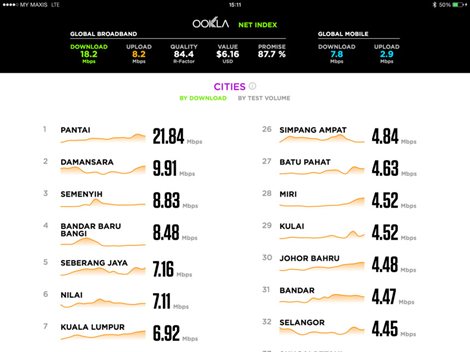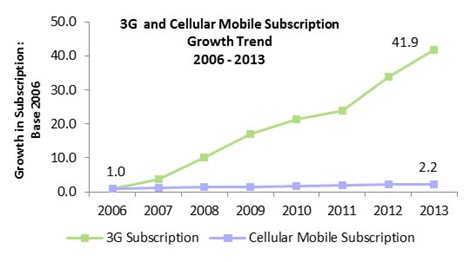CYBERJAYA, 6 May 2014 --- MCMC echoed Dato’ Sri Ahmad Shabery Cheek’s statement in the media today about broadband speeds in Malaysia. The Communications and Multimedia Minister’s scepticism on online data published by
Ookla on Malaysia’s broadband speeds isn’t without basis. Of late, a number of broadband speed tests have been conducted and publicised by various parties reflecting varying results. Each are measured using different methodologies which results in differing outcomes.
“Indeed you will get varying results as there are various reports besides Ookla, like Akamai and ITU. In fact, if you see Ookla’s own test results (
see Fig.1 below), the average broadband speed in Kuala Lumpur is 6.92Mbps and even Pantai shows an average speed of as high as 21.84Mbps. It all depends on where the tests are coming from and how many cities were calculated,” explained MCMC Chairman, Dato’ Mohamed Sharil Tarmizi. “We have a robust and vibrant ISP (Internet Service Provider) market; some may offer higher speeds than others. Consequently, when a speed test is done, the results are averaged out,” he added.
MCMC has long recognized the need to upgrade broadband speeds and quality and since 2010 has pushed for broadband expansion through the implementation of the High Speed Broadband (HSBB) project under the National Broadband Initiative (NBI). MCMC has gone so far as to issue new spectrum on LTE on 2.6 GHz and also allowed the existing operators to upgrade their networks in the 1800 MHz band to LTE. “These networks will take time to build. HSBB phase 1 was completed in over 100 industrials areas, towns and cities and HSBB phase 2 has recently been finalized. In fact, we have already issued the tender for 400 telecommunications towers for the rural areas in Malaysia. Our broadband roll-out plan focuses on the whole nation and not just cities like other countries, so that each citizen will be able to enjoy the connectivity,” said Dato’ Sharil.
Efforts to improve the speeds in Malaysia and the government’s commitment are evident. Prime Minister Dato’ Sri Najib Tun Razak in his Budget 2014 speech announced the implementation of the second phase High Speed Broadband project (HSBB 2) together with broadband to the rural areas carried out in public-private partnership to the tune of RM5.75 Billion for the next three years. (
see Budget Speech 2014 excerpt below)
“In the next three years, we are expanding the roll-out of high speed broadband in city areas to have a minimum speed of 100Mbps and upgrade the broadband in suburban areas to have at least a minimum speed of 4-10Mbps. These are being done through various initiatives for example, by expanding the coverage of fiber-based technology, building 1,000 telecommunication transmission towers for wireless solutions in rural areas, connecting fiber optic cables backhaul to the base stations and building new submarine cable systems between the Peninsular with Sabah and Sarawak,” said Dato’ Sharil.
“Admittedly, we recognize that much more needs to be done. We continually engage the industry in talks to further improve broadband quality and speeds as well as expand coverage. Our own historical data indicates that there has been explosive growth of broadband consumption and it is possible the industry has under-estimated the demand that needs to be fulfilled. For example, 3G subscription since 2006 has grown 42 times,” added Dato’ Sharil (
see Fig.2 below)
Additional Facts
|
The Ookla Speedtest |
The Akamai Test |
Ookla’s methodology is based on a user generated content platform. It compiles data of people in different locations who use the Ookla server to test internet speeds. Only tests results taken within 300 miles of the server are included in the index and the lowest and highest speeds are divided over the number of test points.
The results will differ depending on the broadband packages, population, and country. Furthermore, the results do not distinguish between the different times of day when the tests are carried out when there may be users connecting at Gigabit speeds as well as users connecting at dial-up, satellite or DSL speeds.
The more widespread the broadband coverage the more the results will reflect a lower average download speed unless all the areas covered have very high bandwidth concentration. |
The Akamai test calculates the average connection speed
and the average peak connection speed.
The average connection speed is calculated by taking an
average of all of the connection speeds while the average peak connection speed is taken from only the highest connection speed. Both are calculated during a quarter-year testing period from the unique IP addresses determined to be in a specific country.
Akamai believes that the average peak connection speed is
more representative of internet connection capacity. By using the fastest measurement observed from each unique IP address, those connections that reached maximum throughput rates are reflected. Often, though not always, these connections are associated with the download of larger files, such as desktop applications, games, or software updates. |
The Affordability Report 2013, A4AI (Alliance for Affordable Internet), Malaysia tops the list of 46 countries, in particular emerging economies, on the Affordability Index followed by Mauritius and Brazil. The internet access price that reach majority of the people was the result of the success of National Broadband Initiative (NBI), application of technology advancement alongside with progressive policy and regulatory framework.
http://a4ai.org/wp-content/uploads/2014/01/Affordability-Report-2013_Final-2.pdf
International Telecommunication Union (ITU), Broadband Commission has set out several targets to be achieved by 2015 of which Malaysia has surpassed all the targets way back in 2011. The targets vs Malaysia’s achievements are:
I. Making broadband policy universal; (National Broadband Initiatives launched in 2010)
II. entry-level broadband services should be made affordable in developing amounting to less than 5% of average
monthly income; (Lowest available package RM15 is less than 1% of monthly average income RM2,000)
III. 40% of households in developing countries should have Internet access; (67.3% Household Broadband Penetration)
IV. Internet user penetration should reach 60% worldwide, 50% in developing countries and 15% in Less Develop
Countries; (18.6 million internet users i.e. 63.6% of population)
http://www.itu.int/en/ITU-D/Statistics/Documents/publications/mis2012/MIS2012_without_Annex_4.pdf
Measuring Information Society (MIS) 2013, ITU reported Malaysia amongst the most affordable for Fixed broadband price at entry level which is measured in terms of % of GNI per capita, Malaysia (3.1%), Thailand (5.6%), Indonesia (9.1%), Vietnam (11.3%), Cambodia (34%).
http://www.itu.int/en/ITU-D/Statistics/Documents/publications/mis2013/MIS2013_without_Annex_4.pdf

Fig.1; Source: netindex.com
http://www.netindex.com/download/2,26/Malaysia/
3G subscriptions grew almost 42 times since 2006

Fig.2; Source: MCMC
Excerpt from 2014 Budget Speech tabled by Prime Minister and Minister of Finance Datuk Seri Najib Tun Razak at the Dewan Rakyat on 25 October, 2013.
Expanding Internet Access
51. In a borderless world, information can be obtained instantaneously. Therefore the requisite infrastructure will be upgraded to meet consumer demand. Hence, the Government has implemented the High-Speed Broadband (HSBB) project under the National Broadband Initiative.
52. The collaboration with the private sector has involved investment of RM11.3bil since the 9th Malaysia Plan. The HSBB project has been implemented with Internet access speed of 4 megabits per second (Mbps) and benefiting 2.3 million premises, particularly in urban areas.
53. To expand coverage in major towns, the Government will implement the second phase of HSBB project in collaboration with the private sector involving an investment of RM1.8bil. The initiative is expected to provide additional coverage and facilities mainly in urban areas, benefiting 2.8 million households nationwide. The Internet speed will be increased to 10 Mbps.
54. The HSBB network will be expanded to suburban areas with an Internet access speed increasing to between 4 and 10 Mbps, which will benefit 2 million consumers at a cost of RM1.6bil.
55. To increase Internet coverage in rural areas, 1,000 telecommunication transmission towers will be built over the next three years, with an investment of RM1.5bil. To increase Internet access in Sabah and Sarawak, new underwater cables will be laid within three years, at a cost of RM850mil. These investments will utilise the Universal Services Provision Fund, which is under the purview of the Malaysia Communications and Multimedia Commission.
(End of excerpt)
PDF